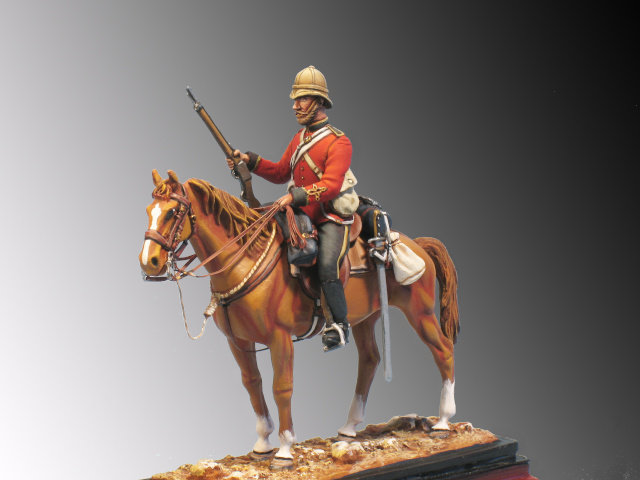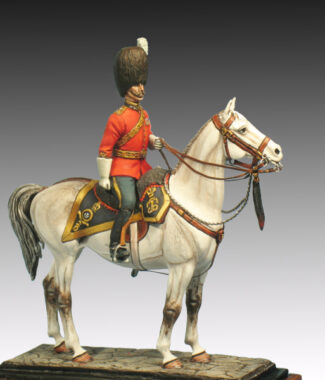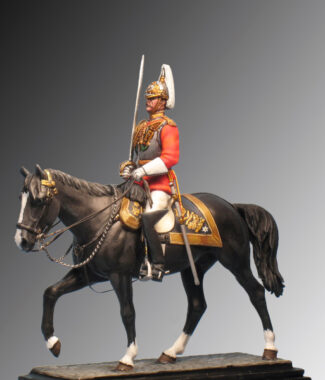You must be logged in to post a review.
1st (The King’s) Dragoon Guards – 1879
€68.00
Figure to assemble and paint
Ref.: 7 – CQV
Weight: 180 grs.
Material: White Metal
Number of Pieces: 10
Historical Review:
Raised in 1685 by Lt Gen Sir John Lanier as Lanier’s or 2nd Queen’s Regiment of Horse.
1714 renamed The King’s Own Regiment of Horse.
1746 became The King’s Dragoon Guards ranked 1st.
1751 renamed the 1st (The King’s) Dragoon Guards.
1921 became 1st King’s Dragoon Guards.
1959 amalgamated with The Queen’s Bays (2nd Dragoon Guards) to become 1st The Queen’s
Dragoon Guards.
This unit was originally raised as the 2nd Queen’s Own Cavalry Regiment in June 1685 to help suppress the Duke of Monmouth’s revolt against King James II. This made it the oldest line cavalry regiment in the British Army. It was named after James II’s wife, Mary of Modena.
It was active in the War of the Spanish Succession (1701-14), forming part of the Duke of Marlborough’s forces – Blenheim (1704), Ramillies (1706), Oudenarde (1708) and Malplaquet (1709). The unit was renamed the King’s Cavalry Regiment in 1714, following the accession of Britain’s new Hanoverian monarch, George I. The regiment was again seen in the War of the Austrian Succession (1740-48), the Seven Years’ War (1756-63), In 1746 the conversion of three former regiments of horse to the 1st – 3rd Dragoon Guards changed their dress, accoutrements, arms, rank and horses tl those of dragoons. Remained for the following the next thirty years in garrison in the United Kingdom. After these years at home, the regiment returned to the Continent in 1815, charging repeatedly at Waterloo (1815) with the Home Brigade. It then joined the Army of Occupation in France for a year. It helped suppress an uprising of French Canadians in Lower Canada in 1838 and fought at Sebastopol during the Crimean War (1854-56). The regiment then deployed to India after the outbreak of mutiny in 1857. It also fought in the Second China War (1857-60), helping to capture the Taku and Peking forts. He spent most of the remainder of the 19th century garrisoned in India, with slots in the United Kingdom.
During the latter stages of the Zulu War, the regiment formed part of the British response to the Isandlhwana debacle. It was sent from England to the Cape Colony to reinforce forces there, arriving in time to take part in the Battle of Ulundi (1879). A detachment of the Dragoons of the Guard under Major Richard Marter stormed the royal kraal of the Zulu King Cetshwayo and captured it. Part of the regiment also fought in the Transvaal War (1880-81). At the turn of the century, it served in the latter stages of the Boer War (1899-1902), taking part in anti-guerrilla operations.
The regiment was active in both World Wars: (1914-1918) and (1939-1945). During the inter-war period, in 1919, it fought in the Third Afghan War (1919), where it made one of the last cavalry charges of a British unit at Dakka. He spent the rest of the inter-war period in England, Germany, Egypt and India, finally returning home to mechanise in 1938. The following year, at the outbreak of World War II, he joined the Royal Armoured Corps.
It can be seen from the figure that the uniform worn by the regiment in the Zulu War of 1879 was that of national service. It appears that they were in such a hurry to reach South Africa that they did not have time to prepare a suitable field kit (wich, by the way, had already been seen in a uniform adapted to the hot climate in India). He wears the scarlet dress jacket, blue trousers with yellow braid and knee-high boots, but with the standard colonial pith helmet warm weather dyed khaki. They wore no gauntlets. He wears infantry cartridge pouches on the front of his usual white belt. He carries his canteen slung from a strap on his left shoulder. He carries a Martini Henry carbine, but no sabre. The straps of the sabre hang from his left belt. This would indicate that the 1864 model sabre was attached to the saddle, as worn in India, and was not made official in the metropolis for all cavalry until 1891.








Reviews
There are no reviews yet.